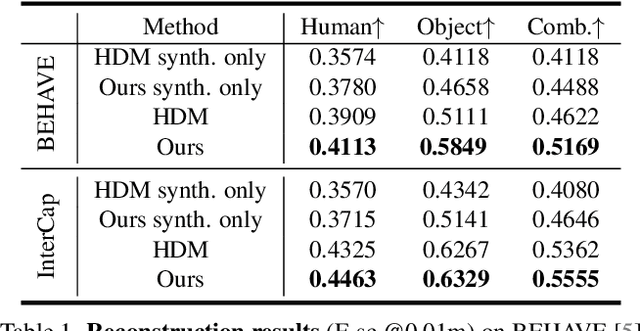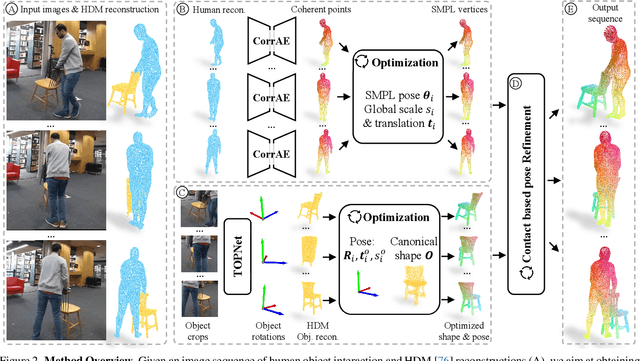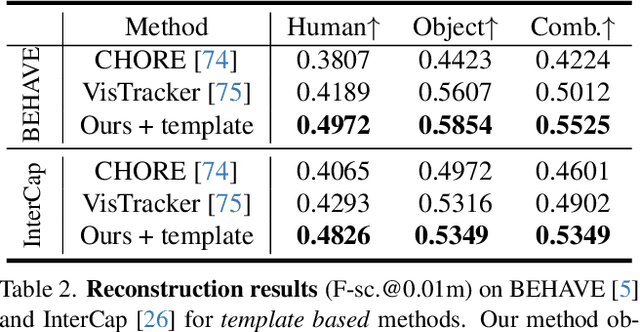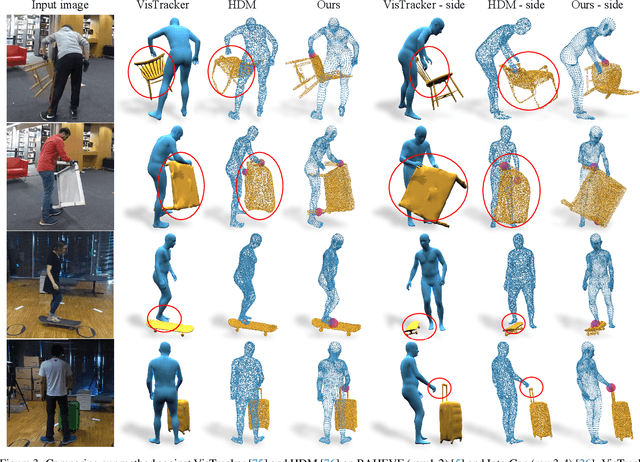Gerard Pons-Moll
MPI for Informatics
SCENIC: Scene-aware Semantic Navigation with Instruction-guided Control
Dec 20, 2024Abstract:Synthesizing natural human motion that adapts to complex environments while allowing creative control remains a fundamental challenge in motion synthesis. Existing models often fall short, either by assuming flat terrain or lacking the ability to control motion semantics through text. To address these limitations, we introduce SCENIC, a diffusion model designed to generate human motion that adapts to dynamic terrains within virtual scenes while enabling semantic control through natural language. The key technical challenge lies in simultaneously reasoning about complex scene geometry while maintaining text control. This requires understanding both high-level navigation goals and fine-grained environmental constraints. The model must ensure physical plausibility and precise navigation across varied terrain, while also preserving user-specified text control, such as ``carefully stepping over obstacles" or ``walking upstairs like a zombie." Our solution introduces a hierarchical scene reasoning approach. At its core is a novel scene-dependent, goal-centric canonicalization that handles high-level goal constraint, and is complemented by an ego-centric distance field that captures local geometric details. This dual representation enables our model to generate physically plausible motion across diverse 3D scenes. By implementing frame-wise text alignment, our system achieves seamless transitions between different motion styles while maintaining scene constraints. Experiments demonstrate our novel diffusion model generates arbitrarily long human motions that both adapt to complex scenes with varying terrain surfaces and respond to textual prompts. Additionally, we show SCENIC can generalize to four real-scene datasets. Our code, dataset, and models will be released at \url{https://virtualhumans.mpi-inf.mpg.de/scenic/}.
Feat2GS: Probing Visual Foundation Models with Gaussian Splatting
Dec 12, 2024Abstract:Given that visual foundation models (VFMs) are trained on extensive datasets but often limited to 2D images, a natural question arises: how well do they understand the 3D world? With the differences in architecture and training protocols (i.e., objectives, proxy tasks), a unified framework to fairly and comprehensively probe their 3D awareness is urgently needed. Existing works on 3D probing suggest single-view 2.5D estimation (e.g., depth and normal) or two-view sparse 2D correspondence (e.g., matching and tracking). Unfortunately, these tasks ignore texture awareness, and require 3D data as ground-truth, which limits the scale and diversity of their evaluation set. To address these issues, we introduce Feat2GS, which readout 3D Gaussians attributes from VFM features extracted from unposed images. This allows us to probe 3D awareness for geometry and texture via novel view synthesis, without requiring 3D data. Additionally, the disentanglement of 3DGS parameters - geometry ($\boldsymbol{x}, \alpha, \Sigma$) and texture ($\boldsymbol{c}$) - enables separate analysis of texture and geometry awareness. Under Feat2GS, we conduct extensive experiments to probe the 3D awareness of several VFMs, and investigate the ingredients that lead to a 3D aware VFM. Building on these findings, we develop several variants that achieve state-of-the-art across diverse datasets. This makes Feat2GS useful for probing VFMs, and as a simple-yet-effective baseline for novel-view synthesis. Code and data will be made available at https://fanegg.github.io/Feat2GS/.
TriDi: Trilateral Diffusion of 3D Humans, Objects, and Interactions
Dec 09, 2024Abstract:Modeling 3D human-object interaction (HOI) is a problem of great interest for computer vision and a key enabler for virtual and mixed-reality applications. Existing methods work in a one-way direction: some recover plausible human interactions conditioned on a 3D object; others recover the object pose conditioned on a human pose. Instead, we provide the first unified model - TriDi which works in any direction. Concretely, we generate Human, Object, and Interaction modalities simultaneously with a new three-way diffusion process, allowing to model seven distributions with one network. We implement TriDi as a transformer attending to the various modalities' tokens, thereby discovering conditional relations between them. The user can control the interaction either as a text description of HOI or a contact map. We embed these two representations into a shared latent space, combining the practicality of text descriptions with the expressiveness of contact maps. Using a single network, TriDi unifies all the special cases of prior work and extends to new ones, modeling a family of seven distributions. Remarkably, despite using a single model, TriDi generated samples surpass one-way specialized baselines on GRAB and BEHAVE in terms of both qualitative and quantitative metrics, and demonstrating better diversity. We show the applicability of TriDi to scene population, generating objects for human-contact datasets, and generalization to unseen object geometry. The project page is available at: https://virtualhumans.mpi-inf.mpg.de/tridi.
Gen-3Diffusion: Realistic Image-to-3D Generation via 2D & 3D Diffusion Synergy
Dec 09, 2024Abstract:Creating realistic 3D objects and clothed avatars from a single RGB image is an attractive yet challenging problem. Due to its ill-posed nature, recent works leverage powerful prior from 2D diffusion models pretrained on large datasets. Although 2D diffusion models demonstrate strong generalization capability, they cannot guarantee the generated multi-view images are 3D consistent. In this paper, we propose Gen-3Diffusion: Realistic Image-to-3D Generation via 2D & 3D Diffusion Synergy. We leverage a pre-trained 2D diffusion model and a 3D diffusion model via our elegantly designed process that synchronizes two diffusion models at both training and sampling time. The synergy between the 2D and 3D diffusion models brings two major advantages: 1) 2D helps 3D in generalization: the pretrained 2D model has strong generalization ability to unseen images, providing strong shape priors for the 3D diffusion model; 2) 3D helps 2D in multi-view consistency: the 3D diffusion model enhances the 3D consistency of 2D multi-view sampling process, resulting in more accurate multi-view generation. We validate our idea through extensive experiments in image-based objects and clothed avatar generation tasks. Results show that our method generates realistic 3D objects and avatars with high-fidelity geometry and texture. Extensive ablations also validate our design choices and demonstrate the strong generalization ability to diverse clothing and compositional shapes. Our code and pretrained models will be publicly released on https://yuxuan-xue.com/gen-3diffusion.
Blendify -- Python rendering framework for Blender
Oct 23, 2024

Abstract:With the rapid growth of the volume of research fields like computer vision and computer graphics, researchers require effective and user-friendly rendering tools to visualize results. While advanced tools like Blender offer powerful capabilities, they also require a significant effort to master. This technical report introduces Blendify, a lightweight Python-based framework that seamlessly integrates with Blender, providing a high-level API for scene creation and rendering. Blendify reduces the complexity of working with Blender's native API by automating object creation, handling the colors and material linking, and implementing features such as shadow-catcher objects while maintaining support for high-quality ray-tracing rendering output. With a focus on usability Blendify enables efficient and flexible rendering workflow for rendering in common computer vision and computer graphics use cases. The code is available at https://github.com/ptrvilya/blendify
Are Pose Estimators Ready for the Open World? STAGE: Synthetic Data Generation Toolkit for Auditing 3D Human Pose Estimators
Aug 28, 2024



Abstract:The estimation of 3D human poses from images has progressed tremendously over the last few years as measured on standard benchmarks. However, performance in the open world remains underexplored, as current benchmarks cannot capture its full extent. Especially in safety-critical systems, it is crucial that 3D pose estimators are audited before deployment, and their sensitivity towards single factors or attributes occurring in the operational domain is thoroughly examined. Nevertheless, we currently lack a benchmark that would enable such fine-grained analysis. We thus present STAGE, a GenAI data toolkit for auditing 3D human pose estimators. We enable a text-to-image model to control the 3D human body pose in the generated image. This allows us to create customized annotated data covering a wide range of open-world attributes. We leverage STAGE and generate a series of benchmarks to audit the sensitivity of popular pose estimators towards attributes such as gender, ethnicity, age, clothing, location, and weather. Our results show that the presence of such naturally occurring attributes can cause severe degradation in the performance of pose estimators and leads us to question if they are ready for open-world deployment.
InterTrack: Tracking Human Object Interaction without Object Templates
Aug 25, 2024



Abstract:Tracking human object interaction from videos is important to understand human behavior from the rapidly growing stream of video data. Previous video-based methods require predefined object templates while single-image-based methods are template-free but lack temporal consistency. In this paper, we present a method to track human object interaction without any object shape templates. We decompose the 4D tracking problem into per-frame pose tracking and canonical shape optimization. We first apply a single-view reconstruction method to obtain temporally-inconsistent per-frame interaction reconstructions. Then, for the human, we propose an efficient autoencoder to predict SMPL vertices directly from the per-frame reconstructions, introducing temporally consistent correspondence. For the object, we introduce a pose estimator that leverages temporal information to predict smooth object rotations under occlusions. To train our model, we propose a method to generate synthetic interaction videos and synthesize in total 10 hour videos of 8.5k sequences with full 3D ground truth. Experiments on BEHAVE and InterCap show that our method significantly outperforms previous template-based video tracking and single-frame reconstruction methods. Our proposed synthetic video dataset also allows training video-based methods that generalize to real-world videos. Our code and dataset will be publicly released.
Neural Localizer Fields for Continuous 3D Human Pose and Shape Estimation
Jul 10, 2024Abstract:With the explosive growth of available training data, single-image 3D human modeling is ahead of a transition to a data-centric paradigm. A key to successfully exploiting data scale is to design flexible models that can be supervised from various heterogeneous data sources produced by different researchers or vendors. To this end, we propose a simple yet powerful paradigm for seamlessly unifying different human pose and shape-related tasks and datasets. Our formulation is centered on the ability - both at training and test time - to query any arbitrary point of the human volume, and obtain its estimated location in 3D. We achieve this by learning a continuous neural field of body point localizer functions, each of which is a differently parameterized 3D heatmap-based convolutional point localizer (detector). For generating parametric output, we propose an efficient post-processing step for fitting SMPL-family body models to nonparametric joint and vertex predictions. With this approach, we can naturally exploit differently annotated data sources including mesh, 2D/3D skeleton and dense pose, without having to convert between them, and thereby train large-scale 3D human mesh and skeleton estimation models that outperform the state-of-the-art on several public benchmarks including 3DPW, EMDB and SSP-3D by a considerable margin.
Human 3Diffusion: Realistic Avatar Creation via Explicit 3D Consistent Diffusion Models
Jun 12, 2024Abstract:Creating realistic avatars from a single RGB image is an attractive yet challenging problem. Due to its ill-posed nature, recent works leverage powerful prior from 2D diffusion models pretrained on large datasets. Although 2D diffusion models demonstrate strong generalization capability, they cannot provide multi-view shape priors with guaranteed 3D consistency. We propose Human 3Diffusion: Realistic Avatar Creation via Explicit 3D Consistent Diffusion. Our key insight is that 2D multi-view diffusion and 3D reconstruction models provide complementary information for each other, and by coupling them in a tight manner, we can fully leverage the potential of both models. We introduce a novel image-conditioned generative 3D Gaussian Splats reconstruction model that leverages the priors from 2D multi-view diffusion models, and provides an explicit 3D representation, which further guides the 2D reverse sampling process to have better 3D consistency. Experiments show that our proposed framework outperforms state-of-the-art methods and enables the creation of realistic avatars from a single RGB image, achieving high-fidelity in both geometry and appearance. Extensive ablations also validate the efficacy of our design, (1) multi-view 2D priors conditioning in generative 3D reconstruction and (2) consistency refinement of sampling trajectory via the explicit 3D representation. Our code and models will be released on https://yuxuan-xue.com/human-3diffusion.
Recent Trends in 3D Reconstruction of General Non-Rigid Scenes
Mar 22, 2024Abstract:Reconstructing models of the real world, including 3D geometry, appearance, and motion of real scenes, is essential for computer graphics and computer vision. It enables the synthesizing of photorealistic novel views, useful for the movie industry and AR/VR applications. It also facilitates the content creation necessary in computer games and AR/VR by avoiding laborious manual design processes. Further, such models are fundamental for intelligent computing systems that need to interpret real-world scenes and actions to act and interact safely with the human world. Notably, the world surrounding us is dynamic, and reconstructing models of dynamic, non-rigidly moving scenes is a severely underconstrained and challenging problem. This state-of-the-art report (STAR) offers the reader a comprehensive summary of state-of-the-art techniques with monocular and multi-view inputs such as data from RGB and RGB-D sensors, among others, conveying an understanding of different approaches, their potential applications, and promising further research directions. The report covers 3D reconstruction of general non-rigid scenes and further addresses the techniques for scene decomposition, editing and controlling, and generalizable and generative modeling. More specifically, we first review the common and fundamental concepts necessary to understand and navigate the field and then discuss the state-of-the-art techniques by reviewing recent approaches that use traditional and machine-learning-based neural representations, including a discussion on the newly enabled applications. The STAR is concluded with a discussion of the remaining limitations and open challenges.
 Add to Chrome
Add to Chrome Add to Firefox
Add to Firefox Add to Edge
Add to Edge